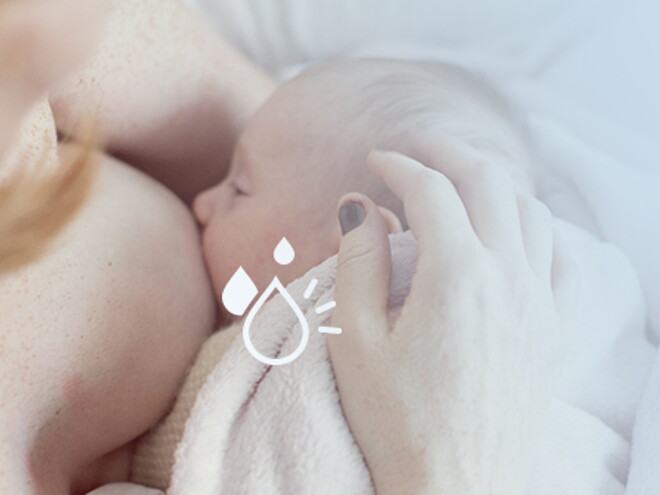
7 steps for a good breastfeeding start
Like any new skill, breastfeeding can take practice and perseverance to master. Follow these simple steps for a smoother journey and it’ll feel like second nature in no time.
Breastfeeding your baby is the best way to give her the nutrition and energy she needs. For some moms and babies breastfeeding comes naturally, but for others it may take a little more patience. Hang in there and don’t be afraid to ask for support if you need it – you’re doing the best for your little one.
Here are some simple ways to get started:
Feed… on demand
When it comes to knowing how often to breastfeed, let your baby lead the way. She will show you signs, which you’ll soon learn to read, of when she’s hungry and full. “Feeding on demand” – a part of “responsive feeding” – is important for helping your baby regulate how many calories she eats.
There is no set schedule or amount for each feeding. We’re all born with the natural ability to tell when we’re hungry or full. By feeding on demand and watching for cues, you’ll help your little one maintain this natural ability, which helps promote healthy growth now and throughout childhood.
Nurse… frequently
Breastfeeding your baby eight to 12 times in 24 hours is perfectly normal. Most newborns will want to feed every two to three hours because their tiny stomachs can only hold so much breast milk at a time. At one day old your baby’s stomach is only about the size of a grape (holding 5-7ml) and by a week is the size of a ping pong ball (holding 45-60ml). It’s no surprise, then, that she needs frequent refills!
If your baby wants to feed more than 12 times a day, go with it. If your baby regularly feeds fewer than eight times a day (or doesn’t seem interested in feeding), you should speak to your healthcare provider.
Practice… skin-to-skin
Laying your naked baby (in just a diaper) on your bare chest has been shown to have many benefits. As well as giving you a precious moment to enjoy your special bond, it can help regulate your baby’s body temperature, encourage her readiness to feed once awake, and increase your milk production.
Wake… for regular feeds
For the first few weeks your baby probably won’t differentiate between day and night and may be ready to feed every two hours or so. Eating frequently is important so she can get the calories, nutrients, and fluids she needs for healthy growth.
If your newborn has slept for four hours straight, gently wake her up for a feeding. You can do this by changing her diaper, holding her skin-to-skin, or massaging her back, belly, or legs. Once your baby is a month old and growing well, you can let her sleep!
Stop… when your baby’s full
Just like there’s no set schedule for feeding, there’s no set time limit for a single feeding. You may find your baby breastfeeds for around 15-20 minutes per breast but this can vary. If she seems full after a quick feeding, don’t pressure her to have more.
Likewise, if she breastfeeds for a long period and is actively sucking, don’t stop her. Let your baby finish one breast completely before offering the other. That way she’ll get the fattier “hind milk” that is released towards the end of a feeding. You may want to make a note of which breast your baby has fed from so you can start with the other breast next time.
Offer… only breast milk
Breast milk contains everything your baby needs. Unless there is a medical need (and you’ve been advised by a healthcare provider), feed her only breast milk for the first six months. Breast milk works on a “supply and demand” basis so if you give your baby something else, your body will get the message that your baby doesn’t need to be fed.
Your milk supply is established based on how much and how often your baby breastfeeds. Check with your healthcare provider about pacifier use. Although pacifier use at bedtime or naptime can be safe for babies, consider waiting for at least three to four weeks before giving a pacifier or offering expressed milk in bottles. This may help to decrease the chance that a baby may get more familiar with the feel of a pacifier, and breastfeed less, or have trouble with latching onto your breast (sometimes known as “nipple confusion”).
Feel… confident
Your body is incredible: it created this beautiful bundle you’re holding in your arms and is now producing the perfect food for her healthy growth and development. The World Health Organization (WHO) recommends exclusive breastfeeding for the first six months of your baby’s life. The recommendation is the ideal, but keep in mind that any amount of breast milk you give your baby provides health advantages.
By practicing these techniques you’ll quickly gain confidence and breastfeeding will soon feel like second nature for both of you. You can feel proud that you’re doing an awesome job and giving your baby health advantages that will last a lifetime!
Breastfeeding takes a little time to master, but there are ways to get there faster. Read “Breastfeeding for beginners: 4 steps for a successful start” to learn the tips and tricks.
Sources
U.S. Department of Health and Human Services, Office on Women’s Health. Your guide to breastfeeding. January 2011.
World Health Organization Infant and young child feeding for health professionals. 2009.
http://womenshealth.gov/breastfeeding/learning-to-breastfeed.html (Accessed December 29 2016)
Last revised: December, 2016









